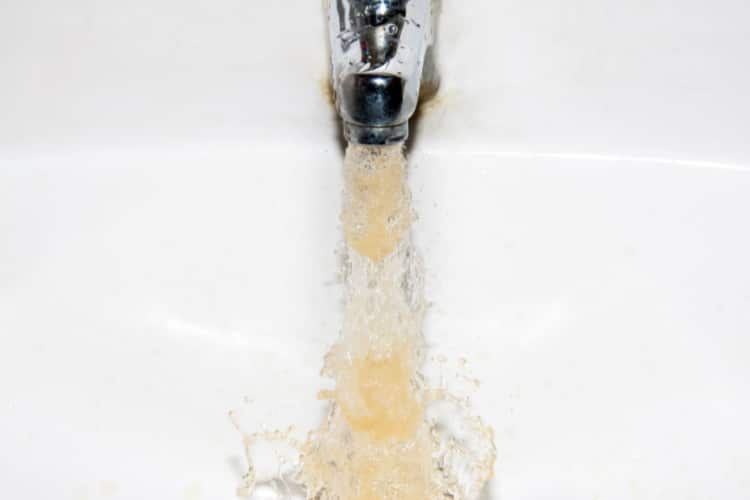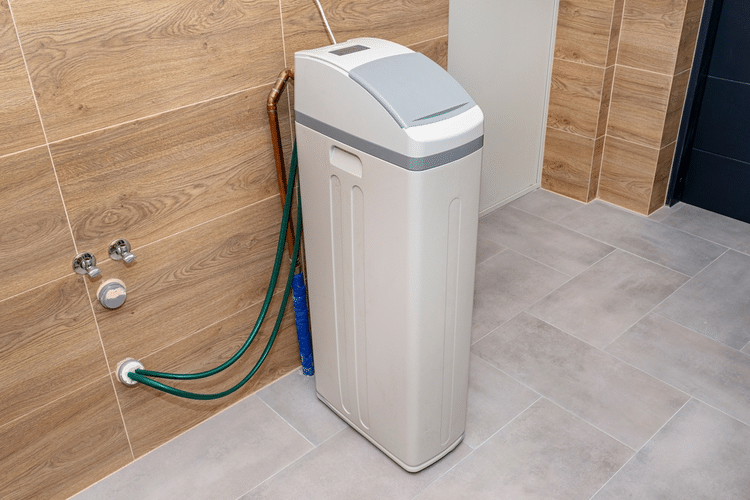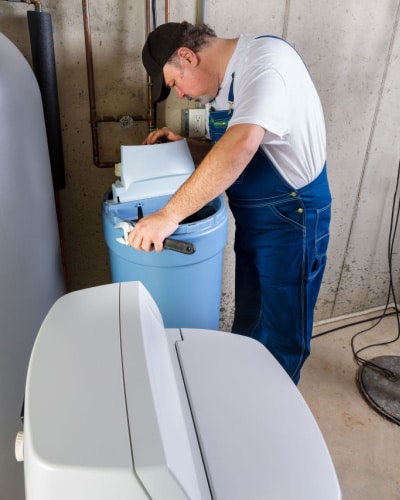If you notice a yellow discoloration of your tap water immediately after installing a water softener, the problem might be due to low-quality resin, too much iron in the water supply, or rust buildup inside the softening tank.
Some affordable water softeners have solvent-free and unsanitized resin, which means that it takes longer for it to be rinsed down. Before putting the device in use, you should sanitize the resin with vinegar or bleach and run a couple of manual regeneration cycles until the yellow tint in the water goes away.

However, this won’t always solve the problem. If yellow water is still coming out from your faucets, then the problem is either due to high amounts of iron in the water source or rust in your pipes. To check if that’s the reason for the yellow discoloration and to make sure that there are no other contaminants in the water, you might want to send a water sample to an EPA-certified lab.
Depending on the results, you can then look for appropriate solutions. For instance, if the results report the presence of other contaminants, it’s best to look for a suitable whole house filtration system that can remove them.
However, before getting into the details of how iron and rust can affect your water softener, we recommend you eliminate other potential reasons behind yellow water that aren’t related to water softeners.
Does Water Softener Remove Rust?

Water softeners are one of the most effective devices when it comes to removing rust (also known as oxidized iron). However, if you’re depending on a private well for your water needs, the iron levels in the groundwater might be higher than your device’s softening capacity.
Iron is generally present in water in two main forms: ferrous iron and ferric/oxidized iron that’s also known as rust. Ferrous iron is invisible and soluble, and water softeners are ineffective against its very minute particles. Ferric (oxidized) iron, on the other hand, is insoluble and red, and since it has large particles, the water softener resin can easily trap it.
That being said, most water softeners are equipped to remove only 2 – 5 mg/L of ferric iron from the water. When the iron levels are higher than 5 mg/L, some of the particles might reach your faucets. On top of that, high ferric iron levels will adversely affect the efficiency of the device’s regeneration process.
In such cases, we recommend combining the softening unit with either a pre-filter or an iron filter that can easily remove excessive amounts of iron. Our experience in the niche has shown that the Springwell combination of well water filter with a softener works best when dealing with high amounts of iron and rust.
Of course, this solution only applies when the iron originates from the water source. If the piping system in your household is rusty, water softeners or iron filters won’t help, and you’ll need to replace the rusty pipes.
Water Softener Rusty After Regeneration

Water softeners operate on the basis of ion exchange, in which the negatively charged resin beads placed in the primary tanks of these devices attract and trap positively charged mineral molecules. A brine solution that’s automatically made in the salt tank of the device keeps the resin positively charged, cleans it, and flushes the trapped minerals down the drain during the regen process.
However, when there’s too much iron trapped in the resin, the brine solution can’t effectively clean it. Instead, it will only set loose the iron particles. When the device restarts softening your water at the end of the regeneration cycle, these loose particles will end up in your faucets.
One way to eliminate this problem is to sanitize the resin tank, but this won’t prevent further occurrences. If you want to eliminate rust problems caused by the water source permanently, your best course of action is to install a pre-filter or an iron filter.
How to Remove Rust From Water Softener
To remove rust from your water softener, you can sanitize it either with bleach or white vinegar. There are also water softener cleaning products that are specifically designed for cleaning resin and brine tanks.
However, our favorite cleaning solution for removing rust from a softening device is the Pro Products Rust Out Water Softener Cleaner. With this product, you can bid rust particles stuck in your water softening resin farewell in four easy steps:
- Fill a bucket with half a gallon of cold water, pour one cup of Rust Out in it, and stir until it dissolves.
- Pour the solution into the brine tank. We advise you to do it when the salt is low because the solution will mix better with water when there’s little salt involved.
- Run a manual regeneration cycle. If you have never run it before, it’s best to consult the instruction manual of the device or directly contact the customer service provided by the manufacturer.
- Test the water by filling a cup and looking at it under a light. If the yellow color persists, repeat these steps until the water is clear.
Conclusion
Sometimes you might notice yellow water coming from your faucets after installing a water softener. To solve this issue, you should first thoroughly rinse down the resin by running successive regen cycles.
If the yellow color isn’t going anywhere, rust is probably the culprit. Rust might be coming directly from the water source or it might be stuck on the water softener resin.
If there’s too much iron or rust content in your water supply, it’s best to boost the softening device’s power with an iron filter that can remove excessive amounts of iron. If there’s too much rust trapped in the water softener resin, you should flush it out by following the steps we provided above.
Put a water softener on my well but the water is still yellow. What can I do to clear it up.
Hi Don, is your system just a water softener or actually a robust water filter/treatment system? Which did you get. Softening your water is not fully treating your water, especially if your source is a well.
I have a well water that oxidizes yellow water just before a regeneration cycle. We have an air exchange iron filter system as well.